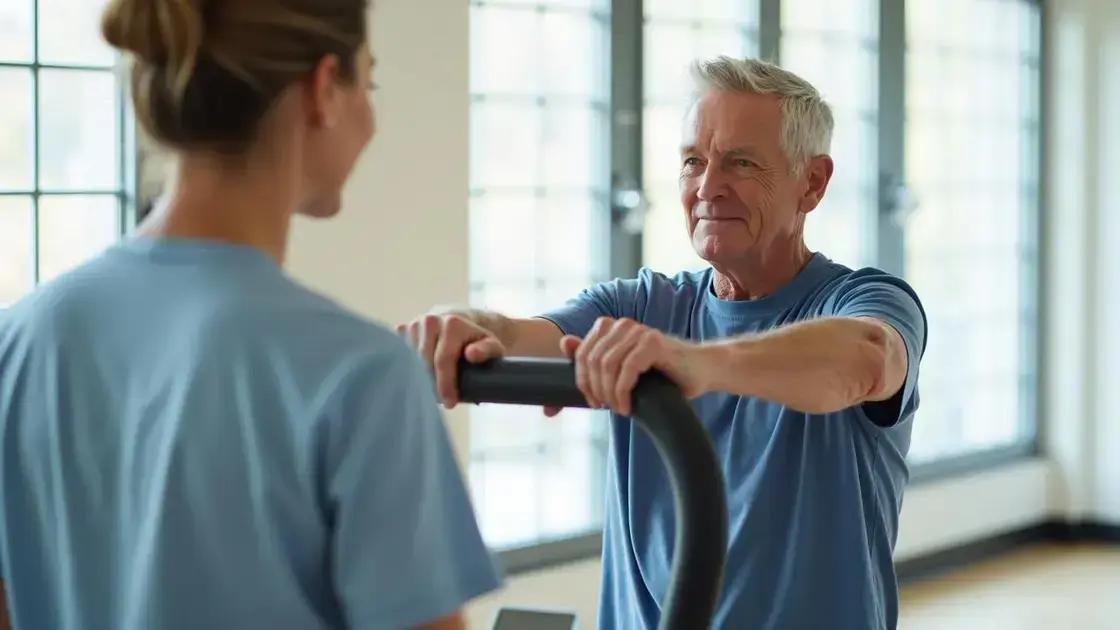The role of isometric exercises in aging fitness includes benefits such as improved muscle strength, joint stability, and flexibility. These low-impact exercises can be easily incorporated into daily routines, but seniors should take precautions like consulting healthcare professionals and listening to their bodies to ensure safety while training.
As we age, maintaining fitness becomes increasingly important. The Role of Isometric Exercises in Aging Fitness is a vital aspect to consider. These types of exercises help enhance muscle strength without requiring significant movement, making them ideal for older adults. In this article, we will dive into understanding isometric exercises, their benefits, how to incorporate them into your routine, and important precautions to take.
Understanding Isometric Exercises

Isometric exercises are unique workouts that involve muscle contractions without any visible movement in the joint angle. This type of training can be performed in various positions, making it accessible for individuals of all fitness levels, especially seniors. Understanding Isometric Exercises is key to reaping their benefits.
Types of Isometric Exercises
There are several forms of isometric exercises, including:
- Static Holds: These require you to hold a position, like a wall sit or plank.
- Resistance Training: Pushing against an immovable object, such as a wall or using resistance bands.
- Bodyweight Exercises: Examples include holding a squat or maintaining a bridge position.
How Isometric Exercises Work
During isometric exercises, your muscles work to maintain tension without changing length, which helps build strength. Instead of lifting or lowering weights, you engage your muscles in a sustained contraction. This can lead to improved muscle stability and endurance, which are important as we age.
Why They Are Beneficial
Isometric exercises are particularly beneficial for older adults because they:
- Reduce the risk of injury since they do not involve dynamic movement.
- Enhance joint stability and mobility.
- Can be modified for various ability levels, making them inclusive.
Incorporating isometric exercises into your fitness routine can provide a solid foundation for maintaining overall health and strength as you age.
Benefits of Isometric Training for Seniors

The benefits of isometric training for seniors are numerous and vital for maintaining physical health. Isometric exercises focus on muscle engagement without movement, which is ideal as we age. Here are some key benefits:
1. Improved Muscle Strength
Isometric exercises can enhance overall muscle strength by targeting specific muscle groups. Regularly holding positions like planks or wall sits can lead to noticeable strength gains, aiding in daily activities.
2. Increased Joint Stability
As we grow older, our joints may become less stable. Isometric training supports joint health by strengthening the muscles that surround and support the joints, reducing the likelihood of injury.
3. Flexibility and Range of Motion
By practicing isometric exercises, seniors can improve flexibility. Holding stretches in a sustained manner helps deepen the stretch while also promoting greater range of motion.
4. Low Impact on the Body
One of the greatest advantages of isometric exercises is that they are low impact. This means they don’t put excessive stress on the joints, making them safe for seniors with arthritis or other joint issues.
5. Convenience and Accessibility
Isometric exercises can be performed almost anywhere, making them convenient. They require little to no equipment, allowing seniors to easily incorporate them into their daily routines.
Overall, incorporating isometric training into a fitness regimen can greatly enhance the quality of life for seniors, promoting independence and physical well-being.
Incorporating Isometric Exercises into Your Routine

Incorporating isometric exercises into your routine can be easy and rewarding. Here are some practical tips to help you get started:
1. Start Slowly
If you’re new to isometric exercises, begin with basic movements. Simple holds such as a wall sit or an isometric plank will allow your body to adapt.
2. Choose the Right Exercises
Select isometric exercises that suit your fitness level. Some effective options for seniors are:
- Wall Sits: Find a sturdy wall and slide down into a sitting position, holding for as long as comfortable.
- Pushing Against a Wall: Stand facing a wall and push against it, focusing on squeezing your muscles.
- Isometric Planks: Lie on your stomach and lift your body onto your forearms and toes, holding the position steady.
3. Incorporate into Daily Activities
You can blend isometric exercises into your daily tasks. For example, while watching TV, hold a seated posture or stand against a wall for a few minutes.
4. Set a Routine
Consistency is key. Aim for short sessions of 10-15 minutes a few times a week. Gradually increase the duration as your strength improves.
5. Focus on Breathing
Remember to breathe normally while holding positions. Proper breathing improves muscle engagement and ensures oxygen flow.
6. Listen to Your Body
Pay attention to how your body feels during exercises. If you experience pain or discomfort, stop and consult a healthcare professional.
By following these tips, you can effectively incorporate isometric exercises into your existing fitness routine, helping you stay strong and active as you age.
Precautions for Isometric Exercises in Aging Fitness

When engaging in isometric exercises, it’s important to take specific precautions, especially for older adults. These tips can help ensure safety and maximize benefits:
1. Consult a Healthcare Professional
Before starting any new exercise program, it is essential to consult with a healthcare professional. They can help identify any potential risks based on your health status.
2. Start with Familiar Movements
If you are new to isometric training, begin with exercises you know and feel comfortable performing. This helps build confidence and reduces the risk of injury.
3. Warm Up Properly
Always warm up your muscles before doing isometric exercises. Gentle stretches and light aerobic activity improve blood flow and prepare your body for exercise.
4. Pay Attention to Your Body
While performing isometric exercises, listen to your body. If you feel pain, dizziness, or unusual discomfort, stop immediately and rest. Pushing through these signals can lead to injuries.
5. Maintain Proper Form
Focus on form and technique while holding positions. This helps prevent injuries. If you are unsure of your form, consider working with a trainer or using a mirror to check yourself.
6. Avoid Holding Your Breath
It’s important to breathe steadily while holding isometric positions. Holding your breath can increase blood pressure and lead to dizziness.
7. Limit Duration
When starting, keep holds brief. Aim for 10-15 seconds, and gradually increase as you become stronger. Overdoing it can lead to fatigue or strain.
8. Have a Cool Down Routine
After your workout, take time to cool down. Gentle stretching helps return your muscles to a resting state and improves flexibility.
By following these precautions, you can safely enjoy the many benefits of isometric exercises while protecting your health.
Embracing Isometric Exercises for Aging Fitness
The role of isometric exercises in aging fitness is crucial for maintaining strength, stability, and overall well-being. These low-impact exercises provide numerous benefits, including improved muscle strength, flexibility, and joint stability, making them especially suitable for seniors.
Incorporating these exercises into a routine can be simple and effective, providing a safe way for older adults to stay active. However, it is essential to take precautions to ensure safety while training. Consulting with healthcare professionals and listening to your body are key steps to avoid injury.
As we age, prioritizing our physical health through targeted fitness practices is important. By understanding and embracing isometric training, we can enjoy a higher quality of life and maintain independence well into our later years.
FAQ – Frequently Asked Questions about Isometric Exercises in Aging Fitness
What are isometric exercises?
Isometric exercises involve muscle contractions without any visible movement, helping to build strength and stability.
What are the benefits of isometric training for seniors?
Isometric training offers various benefits for seniors, including improved muscle strength, joint stability, flexibility, and a low impact on the body.
How can I incorporate isometric exercises into my routine?
Incorporate isometric exercises by starting slowly, choosing suitable movements, including them in daily activities, and setting a consistent routine.
What precautions should I take when doing isometric exercises?
Consult a healthcare professional, warm up, listen to your body, maintain proper form, and focus on breathing during isometric exercises.
Can isometric exercises help with joint pain?
Yes, isometric exercises can help strengthen the muscles around joints, potentially alleviating pain and improving stability.
How long should I hold an isometric position?
Start with 10-15 seconds and gradually increase the duration as your strength improves.












